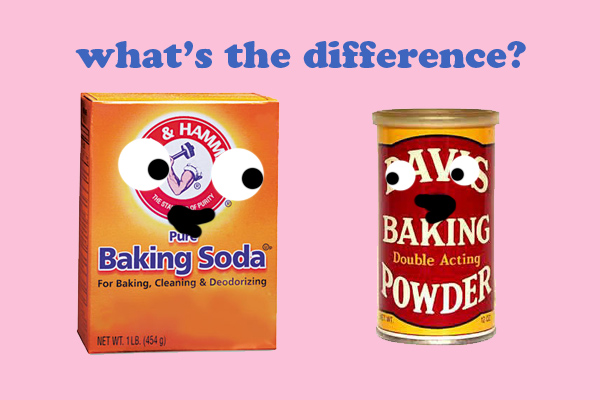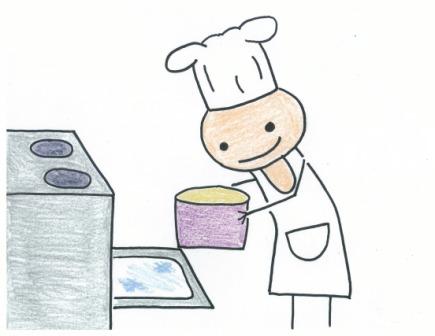Happy April Fools Day! Whether we like to admit it or not, we’re all prone to making mistakes one way or another in the kitchen! It’s important to recognize and correct these mistakes in order to improve our overall baking skills. Today I’d like to share with you all 5 common baking mistakes that I have encountered over the years. After a whole lot of research and a lot of trial and error, I am happy to share my personal experience 🙂
1. Forgetting to Soften Butter

In the words of the beloved Julia Child – “You can never have too much butter“. As we all know, butter is a crucial ingredient in most baking recipes. Nevertheless, not many people are familiar with the true importance of room temperature butter. Butter should always be used at room temperature, unless the recipe says otherwise. Certain recipes such as pie crusts or scones may call for chilled or frozen butter. As a general rule of thumb, butter left on the counter for 1 hour should reach the perfect room temperature consistency. You don’t want it to get too soft/greasy. If you are a ‘spur of the moment’ baker and find yourself in a rush, try chopping up the butter into small blocks and letting it sit near a warm oven. This will definitely speed up the softening process. You can also place the butter in a plastic Ziploc bag and pound it with a rolling pin (this is also a great stress reliever haha).
It might seem resourceful to stick a block of butter in the microwave, but be careful!! Overheating can cause the butter to melt. As you can see in the image above, butter that is just a bit melted has a significant impact on the quality of your baked good. Butter that is overly soft will make cookies spread too thin in the oven, and won’t create that fluffy texture in cake recipes.
2. Treating Frozen Fruit the Same as Fresh Fruit
I absolutely love to bake with fruit, especially blueberries! If you haven’t seen my blueberry lime cake post, check it out here 🙂 . A lot of the time, I tend to buy frozen fruit as fresh fruit can be quite expensive and only in season for a short period of time. If you’re like me and enjoy incorporating frozen blueberries into your baking, you may notice that your muffins/cake will turn a shade of purple-green like the image below …

They may taste amazing, but are not as visually appealing as you would’ve hoped. Luckily, theres a way to fix this! Using frozen blueberries allows the berries to bleed into the batter and further alter the overall colour. I’ve encountered this problem numerous times and I never quite understood why. Here’s the simple solution: rinse the berries in cold water several times. Next, dry the berries in several layers of paper towel, gently rubbing back and forth. Gently fold them into your batter. You may notice several blue streaks throughout the batter, but the overall colour should not change. Now you can achieve the appearance you desired!
3. Equating Baking Powder and Baking Soda
They may sound similar, and look similar, but they are definitely NOT the same! Quite commonly, people believe that baking powder and baking soda can be used as equal substitutes in baking. This is definitely not the case. With respect to similarities, they are both used as a leavening agent in baked goods.
Baking soda (sodium bicarbonate) is about 3-4 times stronger than baking powder. However, more baking soda doesn’t necessarily mean more lift in your baking. You must be sure to use the right amount! Typically, a recipe that calls for baking soda will usually also call for some type of acid as this is required to achieve a chemical reaction. On the other hand, baking powder contains baking soda within it, thus it does not require an acid to neutralize it. Most baking powders are ‘double acting’ which means there are 2 leavening stages. One when the powder gets wet, and the other when it gets heated.
*I had to do quite a bit of research to fully understand the difference between these two. It’s definitely something important to know prior to baking 🙂

4. Opening the Oven While Baking
I know, I know, the urge to open the oven and take a quick peak at your baked goods is always there. Try to avoid this! Its especially important to not open the door near the beginning of the baking process. Even if it’s for a few seconds, opening the oven alters the inside temperature and further causes uneven baking. These fluctuations in heat can even cause a cake to collapse or crack. Resist the temptation, it will be worth it in the end! Set a timer for your baked goods, and try not to open the oven door until the time has elapsed.

5. Not Measuring Properly
We are all guilty of this at one point or another. When I first started baking, I totally thought I could eyeball a tsp or a tbsp….boy was I wrong!! Although it may not seem like a big deal, it can alter the final product. A few months back, I remember reading this post from CookingLight, and was so shocked! Did you know that the difference between a tsp and a tbsp of salt is about 1,200 milligrams?! This is about half of your daily intake. From this point on, I always stick to measuring spoons as an extra pinch of salt or drizzle of oil can make quite a substantial difference.

A lot of the time, professional bakers recommend using a scale as this is the most precise method of measurement. However, the proper use of measuring cups/spoons should yield the same result. When working with dry ingredients, be sure to use the spoon and level approach. Use a smaller cup/spoon to transfer the dry ingredient into the measuring cup and then gently level out the ingredient by sliding off the excess. Although this may seem like an unnecessary task, it is definitely an important part of the baking process.
I hope you all enjoyed! 🙂 I’d love to hear about any other common mistakes/errors you have heard about below!
Don’t forget to subscribe to my blog via email and follow me on Instagram 🙂

Yes this looks handy!!! Thanks for the tips
LikeLiked by 1 person
You’re welcome! Thanks for reading 🙂
LikeLiked by 1 person
I am so bad about eye-balling. You have convinced me – I will try to change my ways!
LikeLiked by 1 person
I’m glad I have convinced you! Eye-balling was always a problem of mine too. Thanks for reading the post 🙂
LikeLiked by 1 person
Great tips! I’m especially bad with opening my oven… I do that relentlessly!
LikeLiked by 1 person
Thanks so much! 🙂 At times it can be so hard to resist peaking at your baked goods!!
LikeLiked by 1 person
I love the idea of pounding the butter in a ziploc back to soften!
LikeLiked by 1 person
Me too, it works quite well! Thanks for reading 🙂
LikeLiked by 1 person
The picture of the cookies made with soft butter, very soft butter, and melted butter is compelling evidence of how important it is to use what is called for in the recipe to get desired results.
LikeLiked by 1 person
I completely agree! Temperature makes a huge difference. Thanks for reading 🙂
LikeLike
Hey I nominated you for an award!
https://thestripedcoyote.wordpress.com/2016/04/14/the-black-cat-blue-sea-award/
LikeLiked by 1 person
Thanks so much! 🙂
LikeLiked by 1 person
This is such a fun post – thanks for sharing your tips! x
https://sarahpratley.com/
LikeLiked by 1 person
Thanks so much! Im glad you enjoyed it 🙂 xx
LikeLike